World Heritage
World Heritage- Republic of Korea
-
Royal Tombs of the Joseon Dynasty
A Glimpse into 500-year History of Confucian Monarchy
In Elementary Learning in Four Characters (Saja sohak), a textbook of Chinese characters for young children in the Joseon Dynasty (1392-1910), there is a phrase that says: “Conduct memorial services with the utmost care to pay tribute to your distant ancestors and respect your roots (追遠報本 祭祀必誠).”
Koreans in the past believed their ancestors were the root of their existence. As an individual was regarded as a bridge between his ancestors and his descendants, there was an inseparable continuity in the bloodline. This deep-rooted tradition of ancestor worship was firmly consolidated during the Joseon era, when Confucianism was the state religion.People had a strong faith in the principles of geomancy. They believed that burying their family members at auspicious sites would lead the deceased to absorb good spirits from earth, and then the souls of the dead would, in turn, bring good fortune to the living descendants. Therefore, taking good care of their ancestors’ graves was considered a duty of all living people. The people of Joseon had absolute respect for their ancestors, so that their graves were also regarded as special places in which their spirits “reside” in a concrete sense of the word. 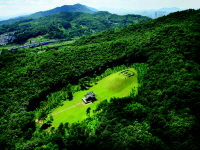
Confucian ethics asked the ruling class to serve as examples of moral conduct for ordinary people. The royal family of Joseon, who were the champion of Confucian world views, attached a special meaning to the tombs of the supreme ruler and his family, and decorated them as solemn and sacred places. In this sense, the royal family took great care to regularly visit their ancestors’ tombs and conduct grand memorial services to set an example for ordinary people and assert the moral authority of the royal family and their rule.
The Joseon Dynasty produced 27 kings during the 518 years of its history from the foundation in 1392 and its collapse in 1910, including the Korean Empire (1897-1910). Royal Tombs of the Joseon Dynasty refer to 42 units of tombs of its kings and queens. Excluding the Jereung of Queen Sineui, the consort of King Taejo (r. 1392-1398), and the Hureung of King Jeongjong (r. 1398-1400), which are located in Gaeseong in North Korea, 40 units of the royal tombs are seated in Seoul and its suburbs. In 2009, all of the 40 royal graveyards in South Korea were inscribed on the UNESCO World Heritage List.
UNESCO acknowledged the historic value of the Joseon royal tombs in terms of their unique architectural style and landscaping based on Confucianism; the ongoing conservation of a living tradition through the performance of prescribed rites; and the integrated management system that is consistent in all the tombs scattered in multiple locations. However, the royal tombs of Joseon are meaningful in ways that surpass being mere burial sites for dead kings and queens, and places with unique architectural and landscaping styles. A tomb’s physical features, such as its location or the identity of the person buried in it, tells us a lot about the owner’s status or the political circumstances he or she was subjected to at the time of burial. Stone structures and objects surrounding the mound, as well as their stylistic characteristics, also offer information about the period’s aesthetics and artistic trends. Constructed in accordance with Confucian doctrines and etiquette for over 500 years, all the 40 royal tombs display a common spatial layout, reflecting the spiritual values cherished all throughout the dynasty. Then again, each of them bespeaks of different political and cultural atmospheres and capabilities at the time of their construction.
Communion of the Sacred and the Profane
The sites for the royal tombs of Joseon were chosen based on their natural surroundings and distances from the capital city Hanyang. One of the most essential conditions was the auspiciousness of the site in terms of geomantic principles - that is, a site where a hill meets a flatland, having its back protected by a hill and facing toward water. It had to be a secluded spot naturally isolated by the neighboring geographical features, and also should be 4 kilometers or more from Hanyang but within 40 kilometers from it. The site should be recognized by geomancers as an auspicious place which would bring good fortune to the descendants of the deceased. It had to be a sacred place far from human activities, which lay separated from nearby towns so that their residents would not have to face any burdens related to attending to the king on his trip to visit the tomb.Once the site for a royal tomb was decided, the compound was divided, according to Confucian etiquette, into the Burial Area (the sacred realm), the Ritual Area (a realm where the sacred and the profane merges) and the Entrance Area (the profane realm). The construction of royal tombs was dictated by a set of prescribed rules detailing the size of the compound, the scale of the mound, and the arrangement of auxiliary buildings and accessory objects, including the stone figures in front of the mound. In spite of the uniformity in the overall layout, each tomb has minor differences in style, reflecting the 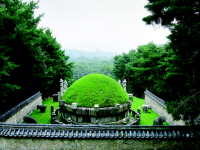
time of its creation. Some of the accessory objects of a tomb - including the protective stone wall and railings around the base of the mound, the stone table in front of the mound, and the stone figures of civil and military officials - show distinctive styles that embody the aesthetics and artistry of the time of the tomb’s construction.
The mound of a tomb was built in various ways accommodating the geographical features of its surroundings. Some tombs have only one mound - for either a person or a couple (danneung or hapjangneung); some have twin or triple mounds arranged in a horizontal row (ssangneung or samyeonneung); and others have two mounds placed in a vertical row (dongwon sanghareung) or on separate spots (dongwon yigangneung) in the same complex. In spite of the diverse arrangement of the mounds, other stylistic elements are basically the same, including the protective stone wall and railings around the base of the mound, and the stone tiger and stone sheep, which were supposed to guard the mound, the low wall and pine trees around the three sides of the mound.
The Burial Area consists of three sections - upper, middle and lower sections - partitioned by long stone beams laid on the ground. The dead king’s spirit was believed to reside under the mound in the upper section, attended by civil officials in the middle section, and military officials in the lower section. In general, the upper section has the stone figures of a tiger and a sheep, a stone table, and a pair of stone pillars, in addition to being surrounded by a semicircular wall. A stone lantern and figures of civil officials are placed in the middle section, and stone figures of horses and military officials occupy the lower section. The periphery of the mound was a place reserved for the owner of the tomb, so that access to it was strictly limited.
The Ritual Area is the place where the living pay tribute to the deceased. A typical memorial service began with the king dismounting his sedan chair and entering the red-spiked gate which signified entering into holy grounds. Then, either the king or the ritual officiants would make a deep bow four times on the bowing stand, and went to the T-shaped shrine set with a table of sacrificial food, walking on the “homage path” consisting of two lanes - one for the spirit of the deceased and the other for the living king. Generally, the T-shaped shrine is surrounded by a few other buildings with specific uses: a stone basin (for burning the written prayer), a servants’ house, a royal kitchen, and a monument pavilion.
The Entrance Area is a space for the management of the tomb and preparation of memorial rites, which has a tomb keeper’s house and storage shed for ritual supplies. The “forbidden stream” in the Entrance Area marks the boundary between the sacred realm inside the royal graveyard and the profane world outside. The bridge over the stream leads to the red-spiked gate, which is the threshold to the Ritual Area.Graveside Rites in Memory of the Deceased
Graveside rites, which have been conducted for the last 600 years, are living traditions which add to the value of the royal tombs. In the Joseon Dynasty, ancestral rites were considered a duty for all humans regardless of their social status. Memorial rites held at the tombs of ancestors were a sacred undertaking that reminded people of the fact that they were part of a bloodline that had lasted for generations, not a lone entity in the universe.Ever since the Joseon Dynasty was founded, the graveside rites have been held by the royal family according to rigorous protocol. Following the liberation of Korea from Japanese colonial rule in 1945, the tradition has been carried on by the Jeonju Yi Clan Association, who have offered a memorial service at the royal tombs on the anniversary of the tomb occupant’s death. Thanks to the graveside rites, the royal tombs of Joseon are more than just a group of memorable works of historical architecture; they are the cultural heritage of a living tradition.
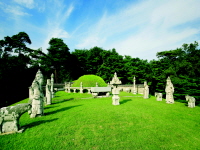
The value of the royal tombs of Joseon as a World Heritage site is further reinforced by the fact that each of the graveyards is a historic site complete in itself, and that the tombs of all the kings and queens have been preserved intact, almost all of them in their original forms and on their original sites.
The 40 units of the royal tombs inscribed on the UNESCO World Heritage List are all located in Seoul and its suburbs. This is because a regulation in Joseon’s oldest law book Grand Code for State Administration (Gyeongguk daejeon) stipulated that all royal tombs should be constructed within 100 li (approximately 40 kilometers) from the city gates of Hanyang. One exception is Jangneung, the tomb of King Danjong, who was killed by his successor amidst political strife. His tomb was recovered and properly titled some 240 years after his death.
What is noteworthy is that the tombs of Yeonsangun and Gwanghaegun, the 10th and 15th kings of Joseon, were not endowed with the title of a king’s tomb. In Joseon, the tombs of the royal family were classified into three categories with different names according to the status of the tomb occupant. The highest category of royal tombs, entitled with a name ending with neung or reung in Korean, has the tombs of kings and queens, including those who were posthumously enthroned. The second category, with a title ending with won in Korean, includes the tombs of crown princes, crown princesses, and the parents of kings who were not kings or queens themselves. The lowest category, with a title ending with myo in Korean, has the tombs of the other lower-level members of the royal family.Many royal couples are buried in the same tomb complex, as exemplified by Heonneung for King Taejong and Queen Wongyeong, or by Yeongneung for King Sejong and Queen Soheon. There are also some royal couples, each of whom occupies a separate tomb complex, as in the case of King Danjong and his consort Queen Jeongsun, buried in Jangneung and Sareung, respectively. In some other cases, a number of separate tomb complexes which are located close to one another form a district of royal tombs. 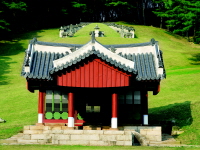
To take some examples, Donggureung, located in Guri, Gyeonggi Province, is a cluster of nine royal tombs, and Seooreung in Goyang, Gyeonggi Province, consists of five royal tombs. In Namyangju in the same province, the tombs of Emperors Gojong (Hongneung) and Sunjong (Yureung) form a district called Hongyureung.
Donggureung, meaning literally “the nine royal tombs to the east of the capital,” is the largest cluster of royal tombs including Geonwonneung, the tomb of King Taejo, the founder of Joseon,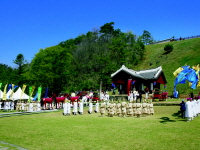
which is located at the absolute back of the district of nine tombs. When King Taejo passed away in 1408, King Taejong took great care to find the most auspicious site for his father’s tomb, sending his geomancers to various places, such as Paju, Goyang, Guri and others, to assess the suitability of these places. Finally, he chose the current site, with pine woods at the back and overlooking an open expanse ahead. Some have associated the shape of the ridge down the hill from the mound with the figure of a retainer bowing to the king. Unlike other royal tombs, the mound of King Taejo’s tomb is covered with silver grass rather than typical lawn grass. It is said that King Taejong had the dirt and silver grass of Hamheung brought to the tomb for his father, who had missed his hometown Hamheung.
Donggureung is an important cultural heritage site, which testifies to the vicissitudes of the dynasty during the 500 years of its existence, as well as the change in the tomb construction style. Besides that, the site has a superb natural landscape with leafy woods all over the district and a stream running across it.
Seooreung, meaning “the five royal tombs to the west of the capital,” is the second largest cluster of royal tombs next to Donggureung. Other than the five tombs of kings and queens, there are tombs of a crown prince, a royal concubine, and a lower-level member of the royal family. The district started to form as Gyeongneung was created here, which is the tomb of King Deokjong. The eldest son of King Sejo, Deokjong died at the age of 20 in the third year of his father’s reign, and was posthumously enthroned later when his son King Seongjong ascended the throne.
The most interesting part of Seooreung is the tombs of King Sukjong and his three queens and one concubine: Queen Ingyeong, Queen Inhyeon, Queen Inwon and Lady Jang Huibin. Queen Inwon’s Myeongneung is located on a higher hill to the left of the twin tombs of King Sukjong and Queen Inhyeon, and Queen Ingyeong’s Ingneung and Lady Jang Huibin’s Daebinmyo are also close to the king’s tomb. Lady Jang Huibin was King Sukjong’s concubine and mother of King Gyeongjong. She was once the woman most loved by Sukjong, but was accused of conspiring against Queen Inhyeon, and died by drinking poison as ordered by the king. Her tomb had been located at a deserted place in Gwangju, Gyeonggi Province, but was moved to this district in 1970.
The concentration of royal tombs in these districts may be because these areas were evaluated to be auspicious sites based on geomantic principles, but some kings’ personal wishes to be buried close to their father or grandfather may also have contributed to the formation of these districts.
There are a relatively larger number of royal tombs in the northern part of Gyeonggi Province, including Seoul, Guri, Goyang and Paju, than in the area to the south of the Han River. For the kings of later generations to make regular visits to the tombs of their ancestors, the distance from the capital city was an important consideration, and having to cross the river must have been considered a burden.
Hongyureung is the most recent of the royal tombs of Joseon. As the tombs of two emperors, Gojong and Sunjong, this complex has a style and layout different from its predecessors. Emperor Gojong proclaimed the founding of the Korean Empire and became an emperor in 1897.
The royal tombs of the Joseon Dynasty are unique examples of historic sites where the tombs of all the kings and queens of a dynasty have been preserved and managed with an integrated management system. Embodying the history, culture and value system of the dynasty that lasted for 500 years, these royal tombs are Korea’s outstanding cultural heritage. In addition, the tomb sites and the adjacent forests, which have been methodically managed since the time of their creation, serve as precious greenbelts for people living in Seoul and its suburbs.



 >
>